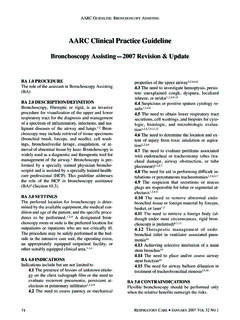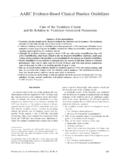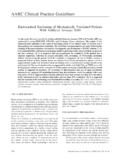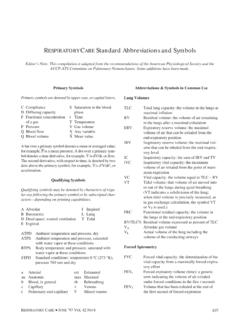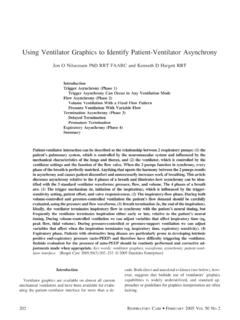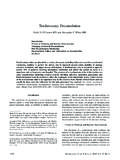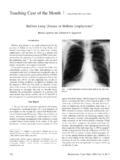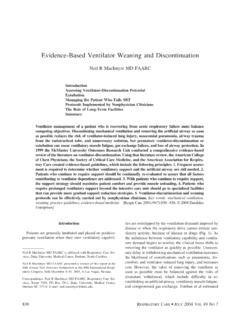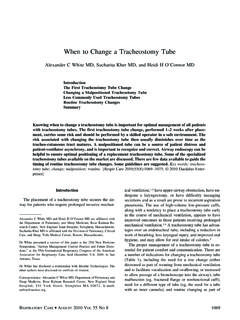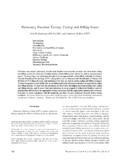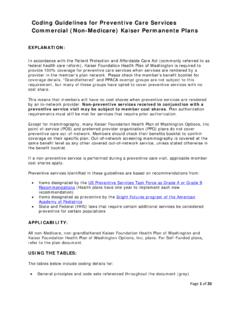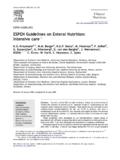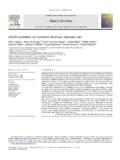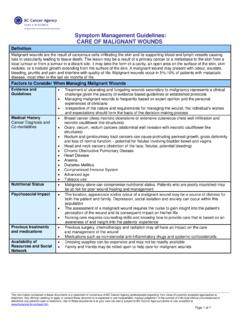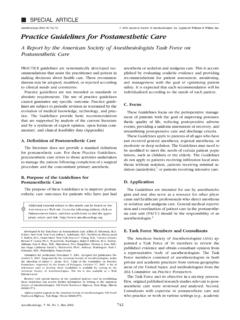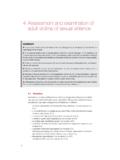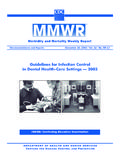Transcription of Long-Term Care of the Patient With a Tracheostomy
1 Long-Term care of the Patient with a TracheostomyJoseph S Lewarski RRTI ntroductionClinical EvidencePatient and Caregiver TrainingTracheostomy Tube Selection and Airway ManagementTracheostomy Tube and Stoma CareSuctioningHumidificationSpeechTrache ostomy Tube Changes and DecannulationEconomic ConsiderationsSummaryAn increasing number of technology-dependent patients are sent home for Long-Term home-man-agement of stable chronic illness. with a Patient who is going to undergo tracheotomy, Patient -education (for the Patient and his/her caregivers) should begin early (before the Tracheostomy , ifpossible), should be individualized to the Patient , and should include basic airway anatomy, medicaljustification for the Tracheostomy , tube description and operation, signs and symptoms of respira-tory and upper-airway distress, signs and symptoms of aspiration, suctioning technique, tracheos-tomy tube-cleaning and maintenance, stoma-site assessment and cleaning, cardiopulmonary resus-citation, emergency decannulation and reinsertion procedures, tube-change procedure, equipment-and-supply use and ordering procedures, and financial issues.
2 There should be a scheduled follow-upplan with the attending physician. A combination of process-validation, through additional re-search, and expert consensus may be needed to standardize the Long-Term care of patients whoundergo words: Tracheostomy , tracheotomy, home- care , caregiver, training, equip-ment, airway care , suctioning. [Respir care 2005;50(4):534 537. 2005 Daedalus Enterprises]IntroductionA growing trend in recent years has been the long-termmanagement of stable but chronically ill and technology-dependent patients in the home. This may be a result ofmyriad factors, including increased economic pressures onacute- care medical facilities, which often result in shorterhospital lengths of stay and efforts to transition patients toless costly points of care . Additional factors may include(1) growing social acceptance of persons with disabilities,which supports the integration of medically fragile andchronically ill persons into the community, and (2) tech-nological advances, which allow lay caregivers the abilityto deliver limited forms of medical care in the home.
3 Thenet result is a population of individuals living at home withvarious medical interventions and technology needs, whowere previously restricted to institutional settings. Amongthis group are those with tracheostomies, which includesinfants, adolescents, and S Lewarski RRT is affiliated with Inogen Incorporated, Goleta, S Lewarski RRT presented a version of this paper at the 20thAnnual New Horizons Symposium at the 50th International RespiratoryCongress, held December 4 7, 2004, in New Orleans, : Joseph S Lewarski RRT, Inogen Incorporated, 120 Cre-mona Drive, Suite B, Goleta CA 93117. E-mail: APRIL2005 VOL50 NO4 The underlying medical conditions contributing to Long-Term - Tracheostomy patients in the home are diverse andmay include but not be limited to patients with upper-airway deformity or obstruction requiring improved air-way management, patients requiring prolonged invasiveventilatory support, and patients with other diseases com-promising the integrity of the upper airway.
4 Regardless ofthe underlying condition, patients requiring Long-Term tra-cheostomy care face a series of common obstacles andshare a set of common EvidenceIn a health care environment moving quickly into anevidence-based approach to medical procedures and care ,there appears to be an absence of such scientific evidencewhen seeking guidance and standards for the long-termmanagement of patients with tracheostomies in the homeor other noninstitutional environment. There are essen-tially no controlled studies or substantial peer reviewedresearch papers to guide care and practice in this field. Ina thorough search of the literature, one finds little objec-tive, controlled scientific data, and, as a result, much of thelong-term Tracheostomy care standard of practice in theUnited States is based on extrapolations of bedside trache-ostomy care performed in acute- care settings. Other fac-tors include local physician practice standards, anecdotalclinical data, third-party insurance payments, and commonsense.
5 One of the most comprehensive documents in thisfield of care is a consensus statement prepared by theAmerican Thoracic Society, entitledCare of the Childwith a Chronic Tracheostomy , which is a very completeset of recommendations derived from a review of the avail-able and relevant published data, along with the consensusof a panel of resource, although morelimited in scope, is the American Association for Respi-ratory care (AARC) clinical practice guideline governingsuctioning of the Patient in the current AARC clinical practice guideline, although well referenced, isspecific to suctioning only and does not effectively ad-dress other issues associated with the Long-Term care ofpatients with on the sources cited above, and on personal ex-perience, the remainder of this article will discuss the com-ponents of a Long-Term Tracheostomy care program (Table1). Patient and Caregiver TrainingEarly discharge planning and Patient /caregiver trainingare required components of the care and treatment of anypatient with a chronic illness, but are of particular impor-tance in managing patients scheduled for discharge with atracheostomy and the associated medical and technologi-cal needs.
6 Experience suggests that Patient and caregivertraining should begin as early as possible and should beadjusted and individualized to the Patient . When possible,training should be initiated in advance of the actual should include the Patient and at least one caregiver,but preferably, two. The details of appropriate Patient train-ing extend well beyond the scope of this overview, but ata minimum should include basic airway anatomy, medicaljustification for the Tracheostomy , tube description andoperation, signs and symptoms of respiratory and upper-airway distress, signs and symptoms of aspiration, suction-ing technique, Tracheostomy tube cleaning and mainte-nance, stoma site assessment and cleaning,cardiopulmonary resuscitation, emergency decannulationand reinsertion procedures, tube change procedure (pedi-atrics), equipment and supply use and ordering procedures,and a scheduled follow-up plan with the attending Tube Selectionand Airway ManagementTracheostomy tube selection is commonly the respon-sibility of the medical facility and physician performingthe initial surgical procedure.
7 There are a number of clin-ical and technical considerations associated with tube se-lection. Clinical considerations may include the structuralshape and anatomy of the airway, ventilation needs via thetracheostomy tube, need for supplemental oxygen, ambu-lation and activity needs, and speech and feeding con-cerns. Technical considerations may include tube brandand material, tubing size (diameter and length), need for acuff, need for fenestration, need for an inner cannula (dis-posable or reusable), need to integrate with other respira-torydevices(eg,swivelconnectors, speakingvalves).Thereis no specific research available documenting the optimalchoices in Tracheostomy tube selection. As a result, localpractice standards and facility device preferences may playa major role in the actual tube 1. Components of a Long-Term Tracheostomy care ProgramPatient and caregiver trainingAppropriate tube selectionAirway management/ventilationTracheostomy tube and stoma site careSuctioning needsHumidification needsSpeechTubing change and decannulationLONG-TERMCARE OF THEPATIENTWITH ATRACHEOSTOMYRESPIRATORYCARE APRIL2005 VOL50 NO4535 Tracheostomy Tube and Stoma CareConsistent with other components of the Long-Term man-agement of the Patient with a Tracheostomy , there is littleresearch or published consensus in regard to long-termtracheostomy tube and stoma care .
8 The frequency of tra-cheostomy tube-changes varies widely and is often drivenby local practice. Nursing journal papers nearly 20 yearsold make reference to pediatric tubing changes in home- care patients on a schedule ranging from daily to is essentially no published or recommendedstandard for adult Tracheostomy tube changes, and againmost current protocols are the result of local and stoma-site care also varies greatly, withno single consensus or science-based standard. Commonhome- care Tracheostomy and stoma cleaning agents in-clude hydrogen peroxide, diluted acetic acid, commercialmedical disinfectants (eg, Control III), and simple soapand water. care standards often evolve from the availabil-ity of reimbursed resources, such as Tracheostomy -carecleaning supplies. Third-party insurance policies often dic-tate practice by limiting the type and quantity of trache-ostomy supplies that will be paid for under the home med-ical equipment and supply insurance benefit. In manyinstances, one Tracheostomy - care cleaning kit per day isthe allowed amount, and therefore common practice isonce-daily Tracheostomy and stoma-site cleaning and a patent airway and effective secretion man-agement are vital components of Long-Term tracheostomycare.
9 Suctioning is defined as the mechanical aspiration ofsecretions from the airway and a necessary part of routinecare of the Patient with a Tracheostomy . The AARC clin-ical practice guideline Suctioning of the Patient in theHome is a relatively complete document that providesguidance that includes Patient preparation, the actual suc-tioning event, and post-suction care . Key elements fromthe clinical practice guideline include self-suctioning train-ing when possible; guidelines for pre-oxygenation or hy-perinflation, which may not be needed for stable homepatients; acceptance and promotion of clean (nonsterile)technique; suction catheter size selection; suction catheterinsertion depth; frequency of suctioning; reuse of suctioncatheters; and consensus opposing the routine use of human upper airway serves as an anatomical heat-and-moisture exchanger, helping to filter, warm, and hu-midify inspired gas. Under normal conditions, the upperairway efficiently adds heat and moisture and thus pro-duces a temperature gradient starting with ambient at thenose, to body-temperature in the lungs.
10 Bypassing the up-per airway may produce unwanted humidity deficit, and asa result it is common practice to provide supplemental heatand humidity to patients with artificial airways. The use ofsupplemental heat-and-humidity systems in conjunctionwith Long-Term - Tracheostomy patients in the home variesgreatly and is, again, often based more on local practicethan on objective scientific evidence. The use of technol-ogy to deliver humidification varies and includes large-volume air compressors for flow-generation, heated pas-sive humidifiers, heated and nonheated jet nebulizersystems, and disposable heat-moisture exchangers. The useof heat-and-humidification systems with adult Long-Term - Tracheostomy patients is often based solely on local clin-ical practice, as there is little science and no consensus onthis subject. Stable adult patients with adequate systemichydration often tolerate little or no supplemental humidityand/or heat, as is often evidenced from clinical practice. Itappears that many stable adult patients become acclimatedto breathing room air via the Tracheostomy , although thereare little to no objective data validating such.
